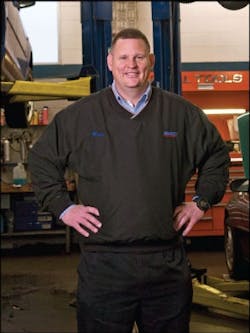It wasn’t that the business was struggling. It was simply stuck.
Mars Overlee had worked at his uncle’s shop, Rick’s 36 Automotive in Stillwater, Minn., since high school. He watched it grow, year by year since the late-1980s, into a well respected, $1.2 million operation.
But the business plateaued, staying right at that $100,000-per-month rate for years.
Overlee had a plan to change that, and when his uncle sold the business to him in 2009, he began putting it into place.
Overlee was going to change the entire business philosophy. He added a day to the workweek, changed the hours of operations, overhauled the company’s customer service strategy—everything in an effort to create a customer-first mindset for his business.
The goal was to increase customer satisfaction, car count and, ultimately, the bottom line.
The early results? Within one year, all but one of his five employees quit.
The Backstory
Overlee never truly considered being a shop owner until his uncle offered him the keys to Rick’s 36 in 2004.
Since graduating from technical college and after a brief stint as a technician, Overlee had been the shop’s service advisor for nearly a decade. It was a role he loved, and the job enabled him and his wife to carve out a nice life for themselves in Stillwater, living in his “dream house.”
“My uncle and aunt sat me down and told me they were looking to retire in about five years and wanted to know if I had any interest in buying the shop from them,” Overlee remembers. “I said, ‘Yeah, of course,’ but I had never really thought about it until that point.
“All of a sudden I had to figure out how I was going to pay for it and what I was going to do once I had it.”
Overlee and his wife made sacrifices to save money for the down payment, including selling their home and moving into a smaller one. His uncle, meanwhile, suggested Overlee seek some managerial training and pointed him toward joining a 20 Group.
It was in his first meeting with Turnaround Tours Inc. that Overlee realized what was impeding his future shop’s growth.
“From going to that group and seeing what the other shops were doing, I saw that we weren’t putting the customer first,” he says.
Short hours, no vehicle pick-up or delivery, a disdain for customers who waited in the lobby for their cars: Overlee saw a laundry list of things that were holding back the shop’s ability to serve customers.
This was in early 2009, and with his uncle just months away from walking out the door, he didn’t want to shake things up.
So, Overlee decided, once the keys were his, everything was going to change.
The Problem
At the time, Overlee thought he was taking it too slowly. In hindsight, he realizes it was just the opposite.
“I realize now that I wasn’t explaining things well enough to my employees,” Overlee says. “They didn’t understand what I was doing, why I was doing it, or how it was going to help us. I just made the changes, and well, they started to leave.”
Six months into his tenure as owner, Overlee began making major shifts in the company’s operations. He started by increasing the hours they were open. Rather than 7:30 a.m. to 5:30 p.m., he opted for a 12-hour day (7 a.m. to 7 p.m.), and he eventually added an 8 a.m. to 5 p.m. Saturday shift. He started taking walk-in customers and did away with the company’s previous appointment-only philosophy. He would take oil changes at any time; he wouldn’t turn customers away. He offered free rides, delivery or pick-up for vehicles, and he stopped treating customers in the waiting room like they were a nuisance.
“At this point, I’d seen how having this type of ‘yes’ mentality with customers worked in a lot of successful shops,” says Overlee, who had attended a number of group meetings by this point and worked closely with other shop owners and the group’s facilitator, Gary Gunn, on implementing these changes. “I had a carefully laid out plan. It’s just my employees didn’t get it, and I didn’t explain it.”
And the employees began to leave. One by one, four of his five staffers, including one who had been with the shop for 21 years, left the company within a year of the changes. For some it was the hours, for others it was working on cars they didn’t want to work on, but overall, Overlee feels it was a lack of understanding.
Overlee was left scrambling and he started to doubt his new approach.
The Options
Overlee tried to seek as much guidance as he could during this time, both from the 20 Group and his uncle.
He had proof of this formula working in other shops, and he was even beginning to see an early increase in car count and revenue, but he wondered if he could build a team to support the new model.
The way Overlee saw it, his choices were pretty clear: “Either I could be held hostage and watch my business being owned by other people,” he says, “or I could become the owner of this business and hire new people and continue on with the vision I had for this company.”
The Decision
In the end, Overlee says, it didn’t take him long to figure out what to do.
“I had some doubts, but I knew deep down that the philosophy I was instructed about and the changes I was making were better for customers,” he says.
“We were going to treat the customer with more respect, and it was going to pay off.”
So, Overlee pressed on. He instituted his changes and started hiring new employees to replace the ones who’d left. To do that, he instituted a new five-step process in hiring to ensure that he found the people that fit his philosophy. It involves developing specific and detailed criteria for each position, weeding out résumés that don’t fit, phone interviews, face-to-face interviews, and then one final interview with the leading candidate.
“It’s about qualifying people out, using the qualifications to eliminate those people who don’t fit,” Overlee says, “and being very careful about who you want in your business. You have to have the right people.”
Slowly, he started building back his staff.
The Aftermath
Sometimes, numbers speak for themselves. Under the new system—and with constant turnover—Overlee was able to slightly increase revenue in 2009 to about $1.25 million. In 2010, the shop reached a record of $1.5 million, and maintained that pace throughout 2011, finishing with slightly better numbers.
Meanwhile, car count went from roughly 325 each month when he took over to more than 400 through 2012.
Mel Kleiman, founder/speaker, Humetrics Inc.
The big thing that’s apparent throughout Mars’s story is that he explained what he wanted done and how he wanted it done, but never explained why he wanted it done. So, there are a couple lessons to take away from this. The first: Communicate, communicate, communicate. You have to explain things. You need buy-in from employees. If you give them the why—hold meetings, sit down with them, tell them how the changes will help them—then they can either be onboard or you know you have to get rid of them. The final thing is that, when you start to see people leave, be prepared: Have people lined up to replace them.
Dan Gilley, president, RLO Training.
Unfortunately, this is too common in our industry. We see shops, whether existing businesses or a new owner taking over, where there’s change and employees don’t react well. To borrow an analogy from Jim Collins (author of From Good To Great), you need to let people know, clearly, that you’re driving the bus and this is where you’re driving it. If they don’t want to be a part of it, that’s fine, you can help them find a shop that fits them. And you should actively help them find another shop, because you have that obligation to take care of your employees. But you have to do this before hand, because you have to know whether people are on-board with your changes or whether you need to part ways. You also have to put people in the right seats on that bus; you need to take a hard look at whether or not those people fit in their positions under the changes you’re making.
And with the additional work and sales coming into the shop, Overlee was able to increase his staff. He now has nine full-time employees.
“It hasn’t been perfect; I still make mistakes,” Overlee says, “but we’ve seen that growth that we wanted, the growth we couldn’t find in the years before.”
Overlee has kept the six-day workweek and has continued to fine-tune his business’s systems and procedures.
He’s also become better at relaying his vision to employees.
“Everything we do is to help the customer,” he says. “I had to get it through to my staff that their uniforms, their paychecks, the new tools they have, the groceries they just bought, I didn’t pay for those. The customers did. So why would we operate around what we want, rather than what the customer needs from us?”
The Takeaway
From talking with other business owners in multiple industries, Overlee has found that his situation wasn’t unique. Often, when ownership changes in a mature business, he says, turnover is inevitable.
He says he is now more careful with getting employee support on changes being made; or, at the very least, he’s better at making sure they know his reasons for doing so.
Overall, though, the entire transition has taught Overlee how to be an owner.
“The biggest thing I can take from this is that this is my business, I have all the money and risk tied into it, and I have to decide what we want and the best way to get there,” he says. “You can’t be held hostage by worrying if your employees are going to quit. You have to take control and make the improvements that you feel will best serve your purposes. You have to do your homework and really make sure you have a firm grasp of it, but in the end, you have to call the shot.”
About the Author

Bryce Evans
Bryce Evans is the vice president of content at 10 Missions Media, overseeing an award-winning team that produces FenderBender, Ratchet+Wrench and NOLN.
